5 min (OPOS ) Milagu Kuzhambu (Pepper Tamarind Stew) by DK on Feb 20, 2017

The foods that we grow up on are correctly termed as "Comfort foods". The rest of the cuisines come and go, but the heart yearns for the food one has growing up, from their mother's kitchen. That familiar aroma, the enticing flavor and loads of love that got transmitted from one's mom to the plate has a huge place in everyone's heart. Its funny when I think about it, but I do realise that it is now my turn to create that kind of memory for my little one. Recently when I looked back, I realised that inadvertently most of the dishes that I cook are the ones from my own mom's kitchen. Guess, that's where my real comfort lies and hopefully my little one finds his too the same way. Bias aside, I truly (and proudly) believe that traditional (Indian) food is beautifully balanced and nutritious. Every region took its climate into account and designed the menu accordingly. Every meal had different components that complimented each other and made it complete - flavor wise and nutrition wise.

Take this recipe - Milagu Kuzhambu for example. Milagu in tamil stands for "Peppercorn" and Kuzhambu is a general term denoting "any type of stew and/or stew made using Tamarind as base". This immensely popular peppery stew is a regular during the winter months to ward of/ relieve cold and provide warmth. The generous addition of rich Sesame oil that's rich in linoleic acid provides anti-bacterial, anti-inflammatory and antioxidant benefits not to speak of the good fat during the cold season. The benefits of Turmeric is already touted but what's not mentioned as often is that all its anti-cancer (and other benefits) are not completely absorbed without the addition of Pepper. These two go together and it's their combination that makes it beneficial for the our body.
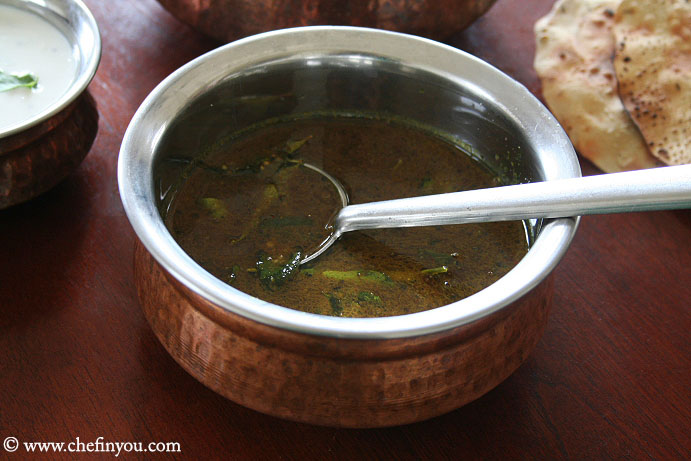
Hence this stew is in a way medicinal - but then most of traditional South Indian foods, when prepared right, are beneficial. While the traditional method of making the Kuzhambu is in no way laborious or time consuming, this pressure cooker recipe using OPOS® methodology makes it even easier and quick - saving not only time and effort but your Gas/Electricity 'cos of less cooking.
Stove Top Method: You can do this over stove top by first adding oil and preparing the tempering ingredients (step 12). Add warm water and when it starts getting heated add the tamarind paste, jaggery along with salt. Let it come to a boil. While that's happening prepare the spice powder (step 9) and grind it with little water to a smooth paste. Add that to the tamarind water and cook until the stew thickens. Serve
Stove Top Method: You can do this over stove top by first adding oil and preparing the tempering ingredients (step 12). Add warm water and when it starts getting heated add the tamarind paste, jaggery along with salt. Let it come to a boil. While that's happening prepare the spice powder (step 9) and grind it with little water to a smooth paste. Add that to the tamarind water and cook until the stew thickens. Serve
- Cook time:
- Prep time:
- Serves: 2-3 People
- Yields: Around 1 cup
Ingredients
- Base
- 3 tbsp Sesame Oil - See Tips
- 2 tsp Tamarind Concentrate (or use 2 tbsp Tamarind puree) - See Tips
- 1 tbsp Jaggery
- 1/2 tsp Turmeric Powder
- Salt to taste
- For the Spice Powder (or use your own recipe)
- 1 tbsp Toor Dal (split Pigeon Peas)
- 2 tbsp Urad Dal (split Black Gram Lentils)
- 1 tbsp Peppercorns - See Tips
- 1 Dry Red Chilli
- For Tempering or use OPOS Tadka (plain)/ OPOS Tadka (with lentils)
- 2 tsp Coconut Oil
- 1 tsp Mustard Seeds
- 1/2 tsp Asafoetida
- Few Curry leaves
Tips
1. Sesame Oil: You can reduce the amount to 2 tbsp.
2. Tamarind Concentrate: I see different brands in shops with different concentration. Hence I would suggest your prudence while using the amount specified. The one I buy is pretty concentrated and hence I use just about 2 tsp that works for my family. If you are not sure, I would suggest erring on the side of less Tamarind than more.
3. Peppercorns: We really love this Kuzhambu peppery. While I mention 1 tbsp for the post, I usually add around 1.5- 2 tbsp Peppercorns. I would recommend starting out with the above mentioned amount and increasing it if needed next time around depending on your level of spiciness. But remember that this stew/kuzhambu should taste peppery.
2. Tamarind Concentrate: I see different brands in shops with different concentration. Hence I would suggest your prudence while using the amount specified. The one I buy is pretty concentrated and hence I use just about 2 tsp that works for my family. If you are not sure, I would suggest erring on the side of less Tamarind than more.
3. Peppercorns: We really love this Kuzhambu peppery. While I mention 1 tbsp for the post, I usually add around 1.5- 2 tbsp Peppercorns. I would recommend starting out with the above mentioned amount and increasing it if needed next time around depending on your level of spiciness. But remember that this stew/kuzhambu should taste peppery.
Method
1.
I would highly recommend sticking to the recipe the first time around to understand the concept, before making any changes until otherwise mentioned. Use only 2L Pressure cooker (should give a long whistle in around 2 minutes when 1/4 cup of water is heated on high flame). Start by adding the sesame oil to the pan. See Tip 1.
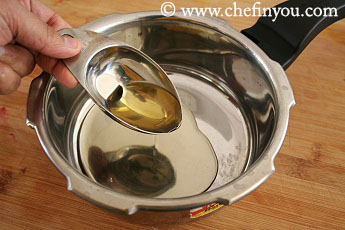
2.
Followed by 1 cup water.

3.
Add the Tamarind concentrate. See Tip 2 before adding.
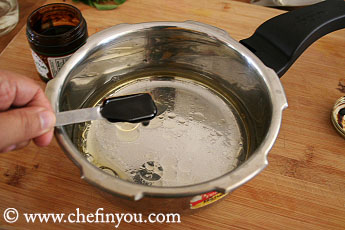
4.
Next goes in Jaggery,
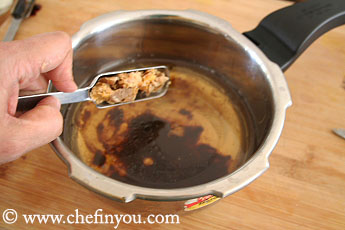
5.
followed by turmeric. Instead of 1/2 tsp you can just add 1/4 tsp as well. Add salt to taste. I added around 1 tsp of sea salt.

6.
Close the lid and cook on high flame for around 4 minutes or 2 Whistles.
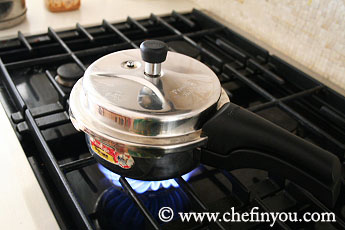
7.
Don't let it cross the 5 minute mark. Simply switch off the flame in that case and check your pressure. The pressure might be leaking on the sides (time to change caskets in that case).
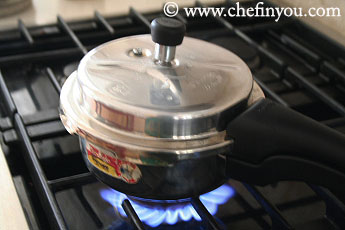
8.
I think my first whistle came around 3:50 mark followed by the second one at 4:20. After 2 Whistles, switch off the flame and let the pressure settle down. You can also manually release pressure with the help of a spoon. Be careful to stay out of way from the releasing steam to avoid scalding your skin.
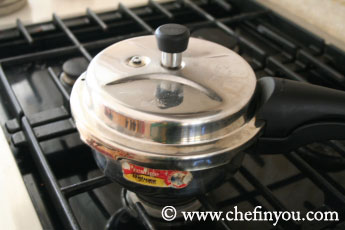
9.
While that's cooking/settling, you can alternatively dry roast the spices. The powder can be your own recipe as well. This is the way my mother makes hence I follow the same spice powder esp given that the family prefers it.
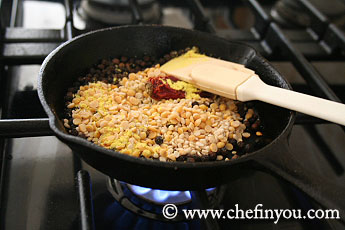
10.
When slightly brown, switch the flame
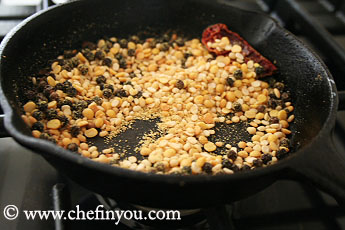
11.
and grind it using a spice grinder/mixie to a fine powder.
P.S: I love to use my mortar and pestle for this for enhanced flavor/aroma. Also, for that arm workout when I am not in any time crunch. It does take time though I feel the results are worth the effort.
P.S: I love to use my mortar and pestle for this for enhanced flavor/aroma. Also, for that arm workout when I am not in any time crunch. It does take time though I feel the results are worth the effort.
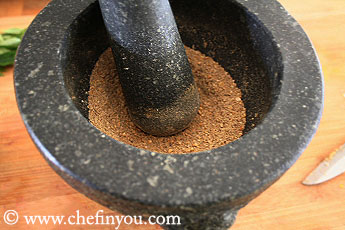
12.
Now use the same skillet to Temper. Heat the pan and add the oil. Once hot, add the mustard seeds. When it stops popping, add the asafoetida and switch off the flame. Add the curry leaves. You can eliminate this step by using OPOS Tadka (plain)/ OPOS Tadka (with lentils) if you have it ready on hand. Makes life easier!
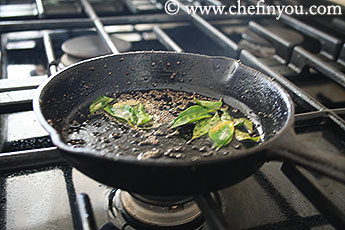
13.
Open the pressure cooker

14.
and add the (1/4 cup) spice powder to it along with the tempering. You can also use some ghee for enhanced flavor. I usually add it to my steamed rice hence skip it here.
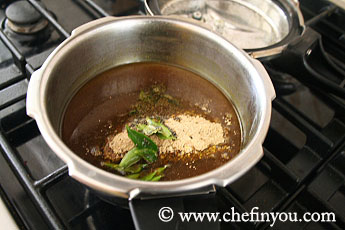
15.
Give it a good mix until combined.
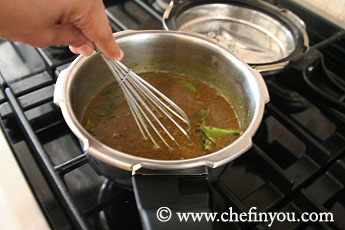
16.
Close the lid back and let it sit for 10min. Don't have to heat it again.
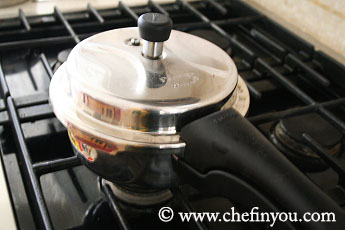
17.
You will find that it thickens on cooling.
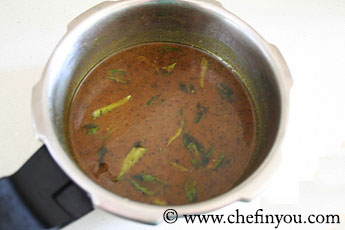
A little goes a long way. Add oil/ghee to steaming hot rice and little Kuzhambu to your plate. Start with 1/4 cup of the stew, mix and add more if needed upon tasting. Dangar Pachadi and/or Paruppu Thogayal make awesome combination to Pepper Kulambu.
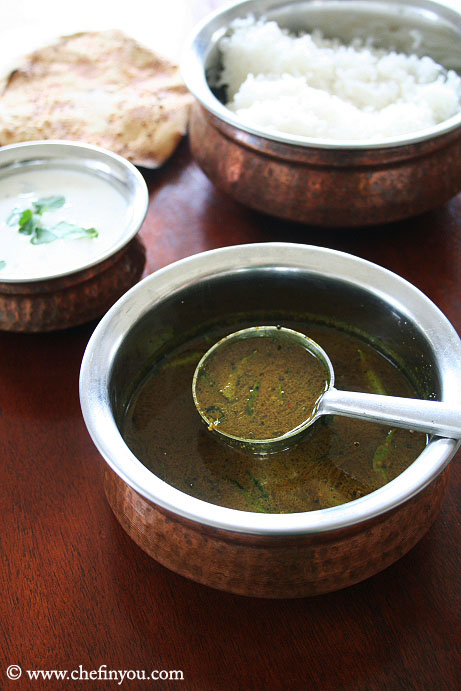
Filed Under these categories
- 291 Dairy Free
- 39 Easy Rice Recipes
- 447 Gluten Free
- 705 Kid Friendly
- 55 Kids Main Course Recipes
- 384 Nuts Free
- 8 OPOS Main Dishes
- 18 OPOS- One Pot One Shot Recipes
- 9 Stews
- 5 Stews
- 177 Sugar Free
- 73 Under 15 minutes - Main Course
- 499 Vegan Recipes
Ideal Accompaniments
Kuttu Ki Puri (Buckwheat Poori) By DK on Oct 20, 2012
Homemade Tamarind Paste (OPOS®) By DK on Nov 8, 2017
OPOS Bottled Tadka (with Lentils) By DK on Mar 1, 2018
OPOS Bottled Tadka By DK on Feb 14, 2018
Dangar Pachadi (Raita using Urad Flour) By DK on Feb 6, 2017
Related FAQs
Related Articles
Recipe Reference
OPOS® Manual for methodology and Mom's recipe
Related Posts
Vendhaya Kuzhambu (Fenugreek-Tamarind Stew) By DK on Feb 20, 2012
Homemade Tamarind Paste (OPOS®) By DK on Nov 8, 2017
6 min Mor Kulambu (OPOS©) By DK on Sep 4, 2018
South Indian Tamarind Rice By DK on Jan 8, 2010
Bhindi Kadhi (Yogurt Stew with Okra) By DK on Sep 12, 2011
Kajur Imli Ki Chatni / Date Tamarind Chutney (Chaat) By DK on May 15, 2018
Leave a Reply
I love to hear from you! I read each and every comment, and will get
back as soon as I am able to.
5 Comments
By Divya on Mar 2, 2018
I have made this quite few times since I saw your recipe. Comes out perfect. Thanks. In the same opos way, can you show Varsha kulambu that is made with small onion?
Hey Divya, thank you. Just a small clarification - did you mean vatha kulambu? --DK
By veena on Jan 28, 2018
You did not mention how much water, I made it and use water based on my own requirement. Other then that it was really good love it!
I do Veena. Please refer Step 2. --DK
By prasad on May 29, 2017
Excellent,very innovative we enjoyed while eating and preparing,post as many recipes of Iyangar cooking we love the recipes of tamil nadu cooking
Thank you for your feedback Prasad. I def will post more :) --DK
By Ranganathan on Feb 20, 2017
I will try to do this.





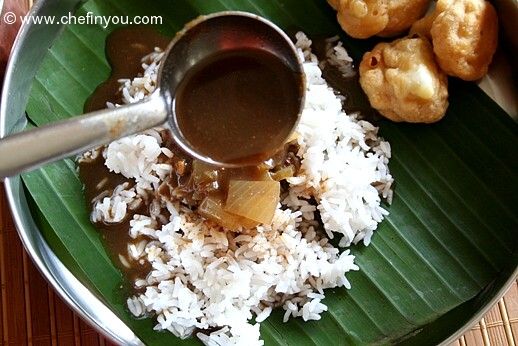

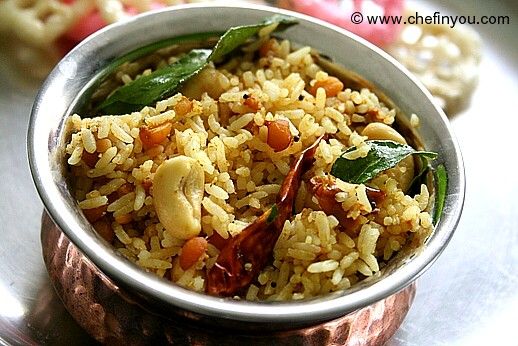
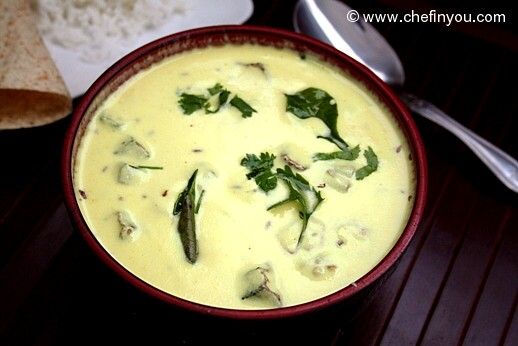

By Gayatri on Mar 6, 2018
Kandippa :) --DK